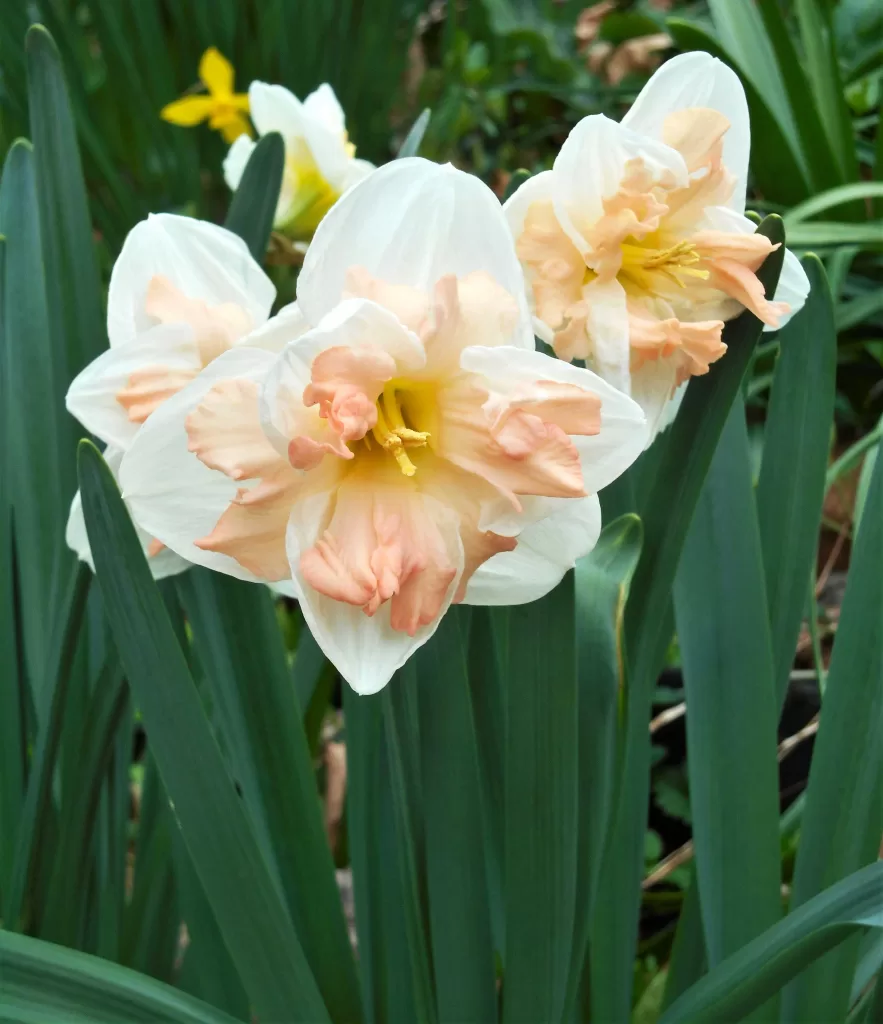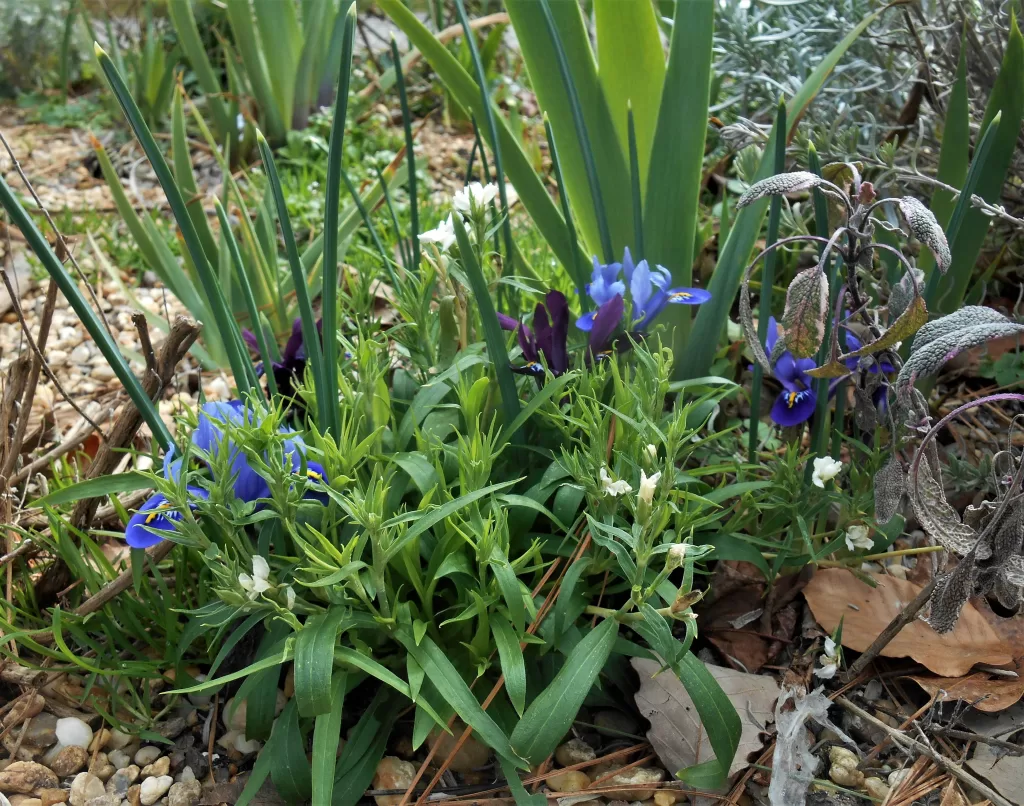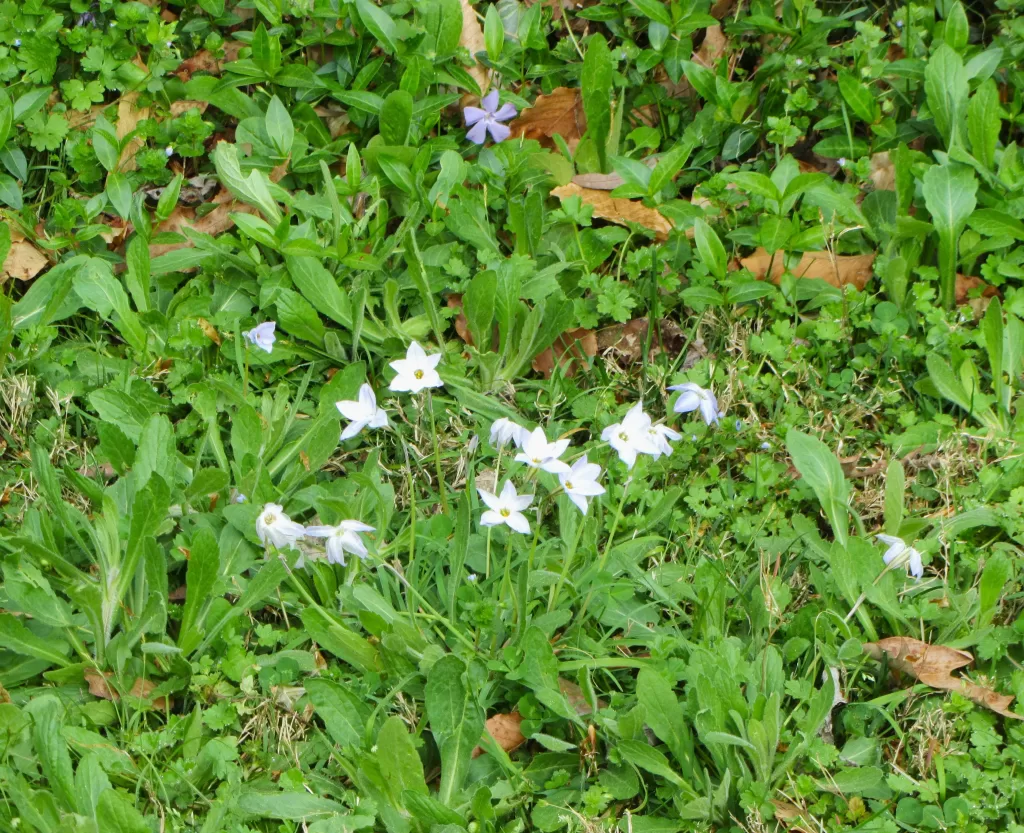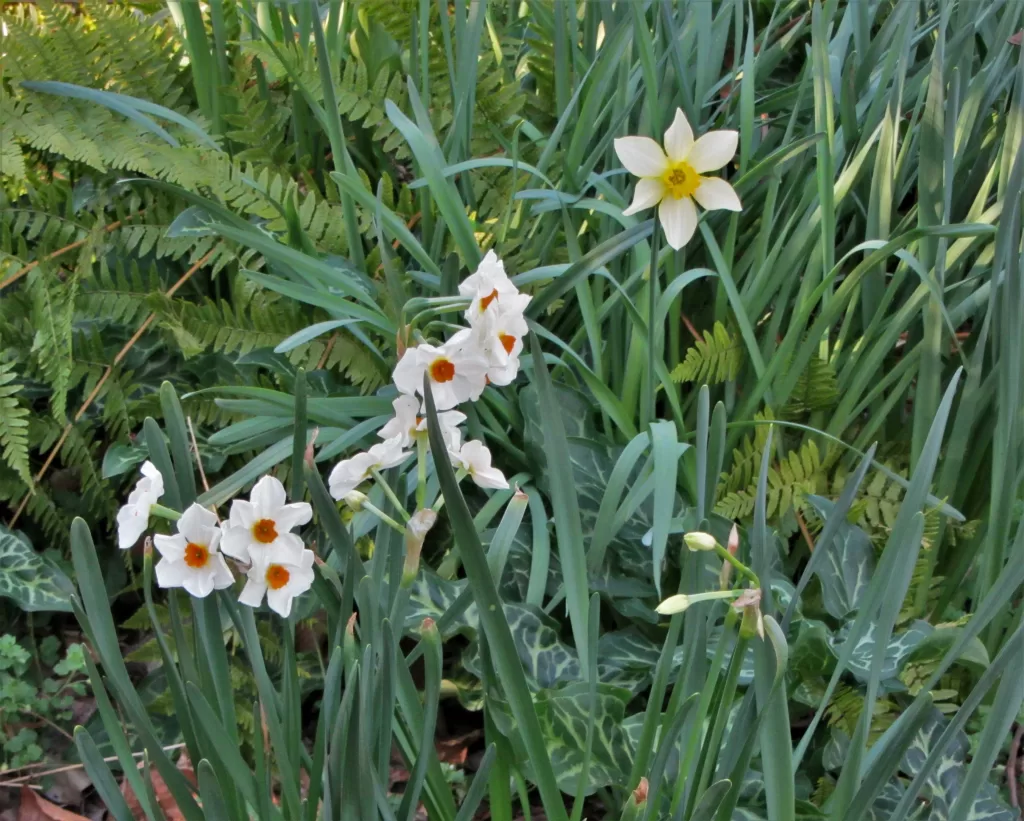Why Bother With Bulbs?
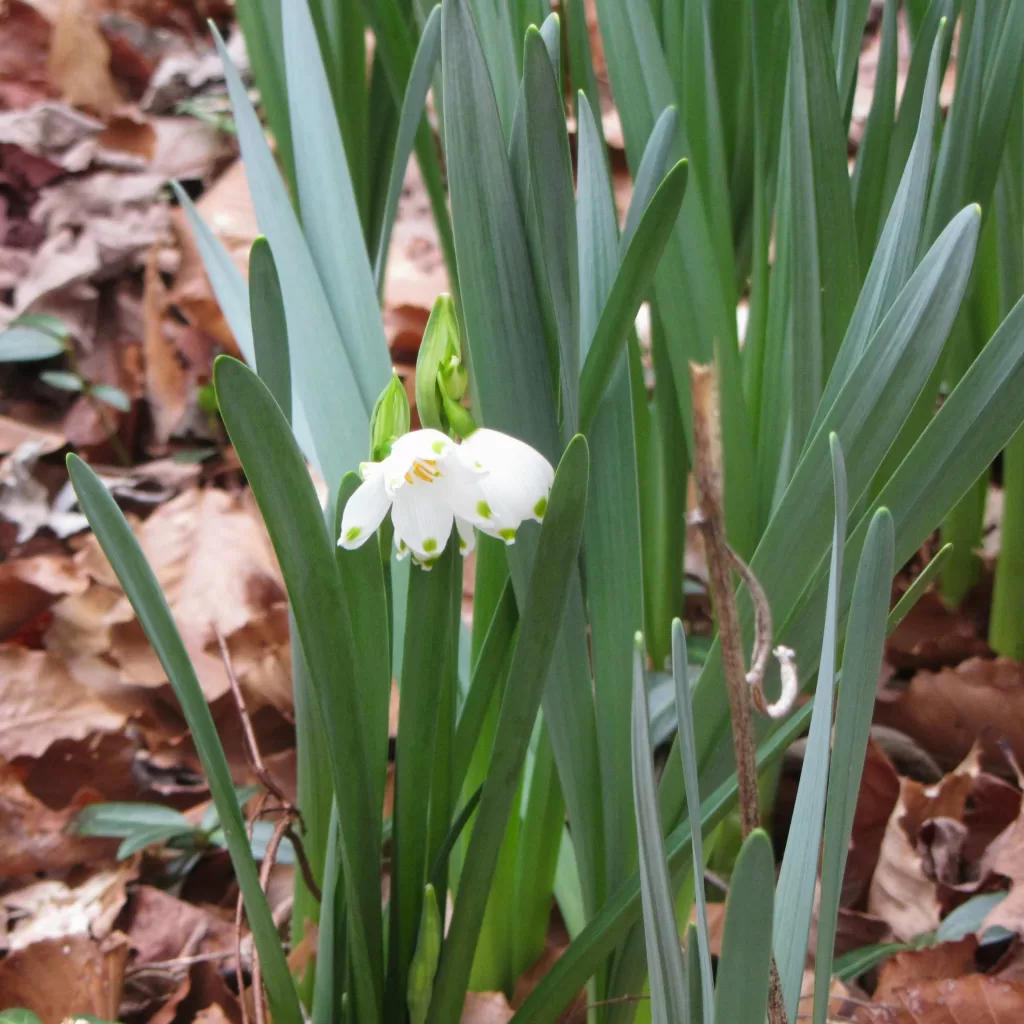
Leucojum aestivum ‘Gravetye Giant may be confused with Galanthus ssp. They bloom a bit later and grow a bit larger.
Bins of papery brown bulbs appear in every garden center and big box store right after the back-to-school displays disappear for another autumn. I love to study the photos of bright spring flowers on the bins, bags, and boxes of bulbs. They invite the ultimate impulse purchase. “Where to plant them?” you may wonder. No matter, you’ll find a spot.
As trees turn gold and scarlet, we feel the chill in the air, and know that the long summer season turns at last. Winter lurks over the horizon of the holidays, drawing closer with each passing day. This is when we begin to dream of spring, and those first, bright flowers of a new season tentatively poking up through winter’s mud.
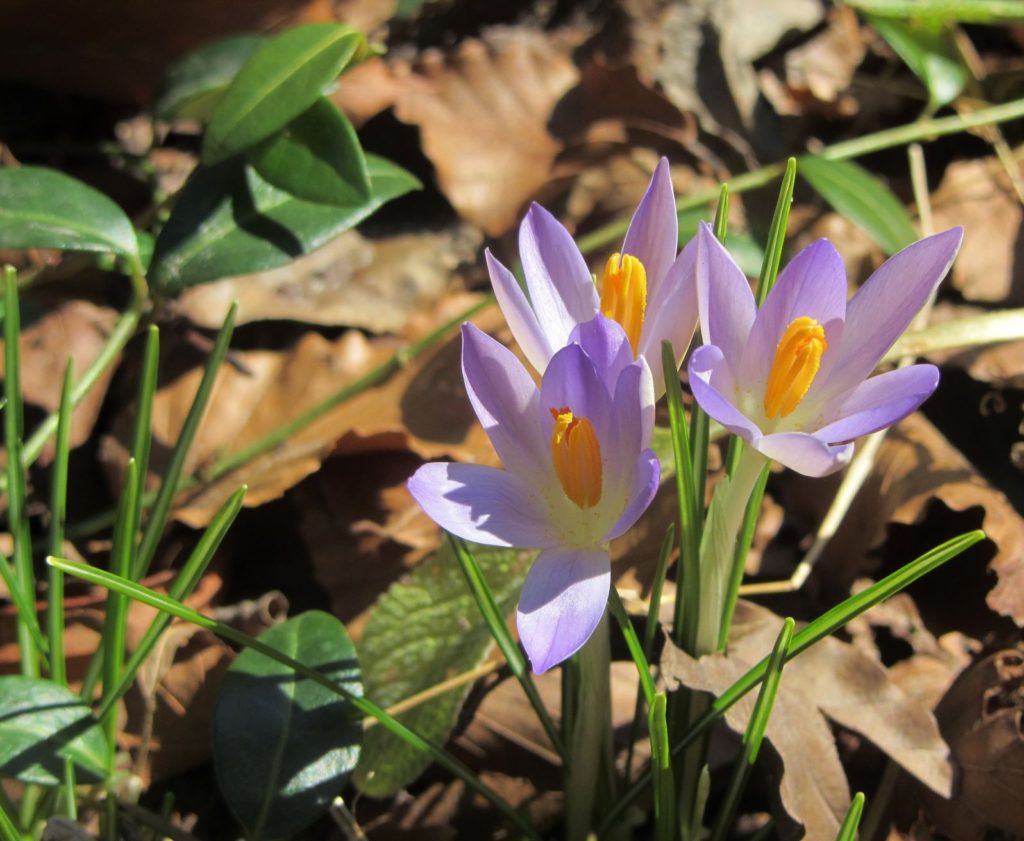
Crocus tommasinianus is the species of Crocus most resistant to wildlife grazing. Their abundant pollen and rich nectar support pollinators during the last weeks of winter.
Before the grass turns green, before the trees clothe themselves in new leaves, we know that the daffodils will bloom one chilly, late winter day. Daffodils and Crocus, Galanthus, Scilla, and miniature Iris; all of these tiny, jewel-like flowers will emerge, magically, from a handful of dry, unimpressive bulbs.
Maybe you have more self-control than some of us, who will not be named, and can walk past the bulb displays with hardly a glance. Maybe you consider them an extravagance, an indulgence, an extra chore for which you have no time. Or maybe you have no self-confidence that they will grow for you.
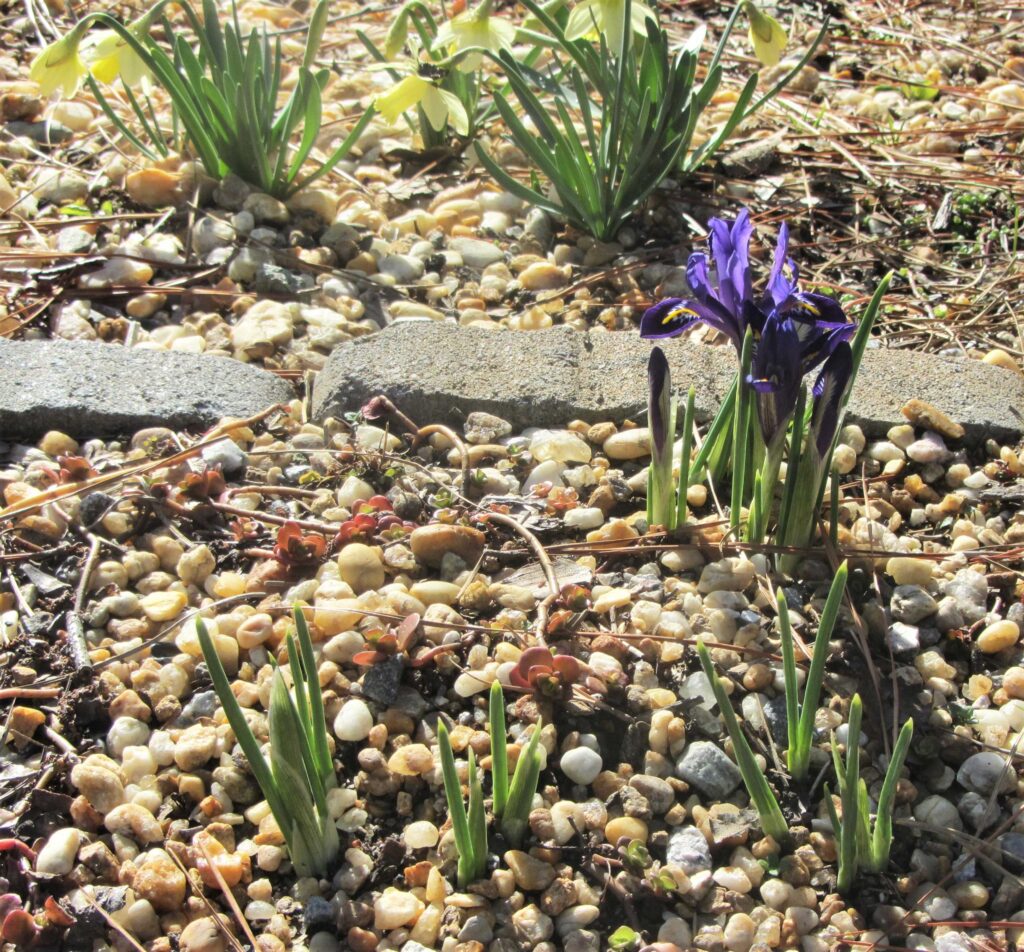
Iris reticulata, which grow from small bulbs, want dry soil during the summer. These bloomed in the gravel garden at Williamsburg Botanical Garden and Freedom Park Arboretum in 2022.
Maybe you shun them since most originate from Europe, the Middle East, and Central Asia. Their linage is long, as they adapted over centuries of growing wild on rocky, arid mountains and in unkempt meadows. These magical little flowers play a part in Greek mythology and medieval history. They have a reputation as objects of botanical compulsion and desire, perhaps attracting a cultish following better suited to a nice native holly or oak tree.
Watching these little bulbs bloom is watching living history unfold before your eyes. Some grew in Babylon and in Egypt. Others passed through the hands of Venetian traders and were traded to the Chinese during the age of the Knights Templar. Some of the most expensive goods in those long-ago days, saffron and tulip flowers, grew from little bulbs just like those we know today.

Galanthus and Crocus grow with Cyclamen beneath a potted shrub at the Williamsburg Botanical Garden in February 2019.
But, you may reply, “These aren’t native plants. I don’t want them my garden.”
Fair enough. And I would ask you, “What in your native garden blooms for you in January? Or in February? What forage do you grow for the bees and other native insects who venture out on fine, sunny winter days?” What is your first real sign of spring?”
Beauty has its own purpose and doesn’t need any justification beyond its own existence. The only reason people have needed, through the ages, to grow these jewel-like geophytes is the pleasure gained from watching them unfold. Their very existence is reward enough for taking a moment to plant them in a bit of Earth in a container or the garden’s soil.
And while that is true, I will offer you a few more reasons to indulge in this most simple pleasure, spring flowers from bulbs:
- Many early spring bulbs provide rich, nutritious pollen and nectar for a variety of early pollinators. Siberian squill, Scilla, some varieties of which have blue pollen, feed domesticated and wild bees from the moment their first petals open and for the next several weeks. Crocus flowers are also rich in golden pollen. Saffron is made from the stamens of some species of Crocus. Some insects or mollusks also eat petals of these early bulbs. Some Narcissus ssp. bloom as early as December in our region, and certainly by mid-January, welcoming a variety of hungry pollinators.
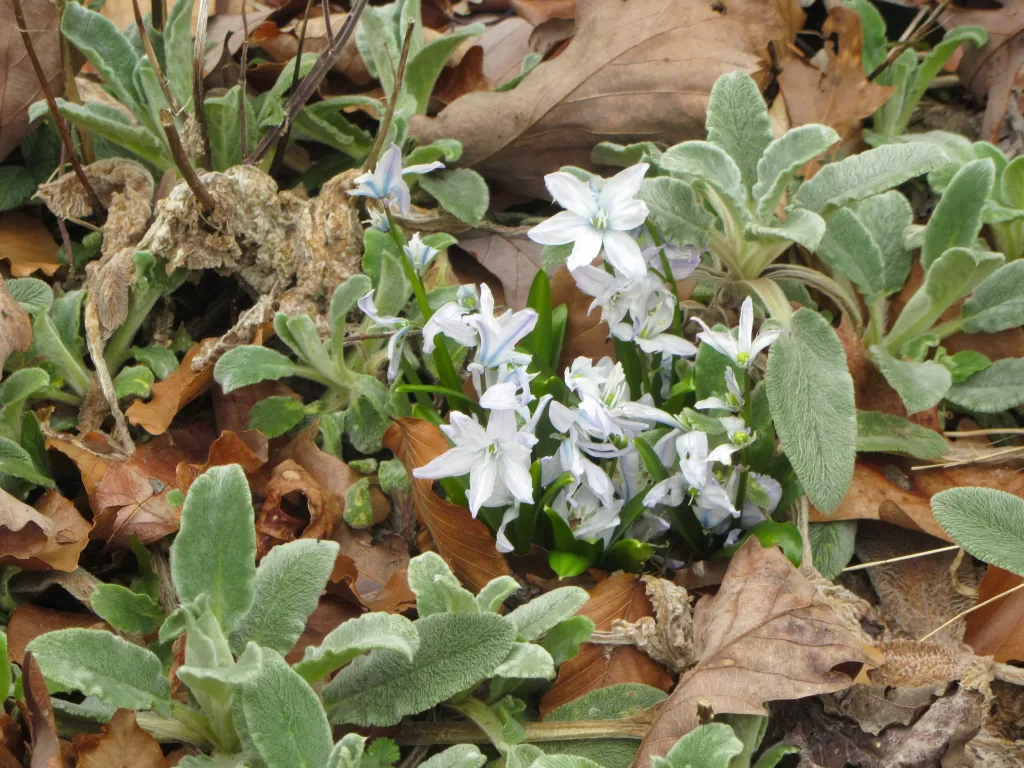
Siberian squill provide food for wildlife even as they emerge. Pollinators visit and other insects have eaten some of their petals. February 2024.
- The sheer beauty of bright, delicate flowers after weeks of winter lifts our spirits. The flowers promise that spring is not far away. The mental health benefits of winter and early spring flowers are enormous, especially when the weather remains grey and wet. A few daffodils may be the only bright spots in the landscape. Tiny bulbs, like Iris reticulata, may appear and bloom almost overnight, delighting us with a happy surprise when we notice them.
- Bulbs extend the growing season and allow us to make each planting area more productive. Most bulbs bloom for a few weeks, and their leaves soak up sunshine to refuel the bulb for next year’s flowers before fading away. The foliage usually lasts six to eight weeks after the blooms fade, and then all traces of the plant disappear. Bulbs can be planted under and among grasses, ferns, and herbaceous perennials.
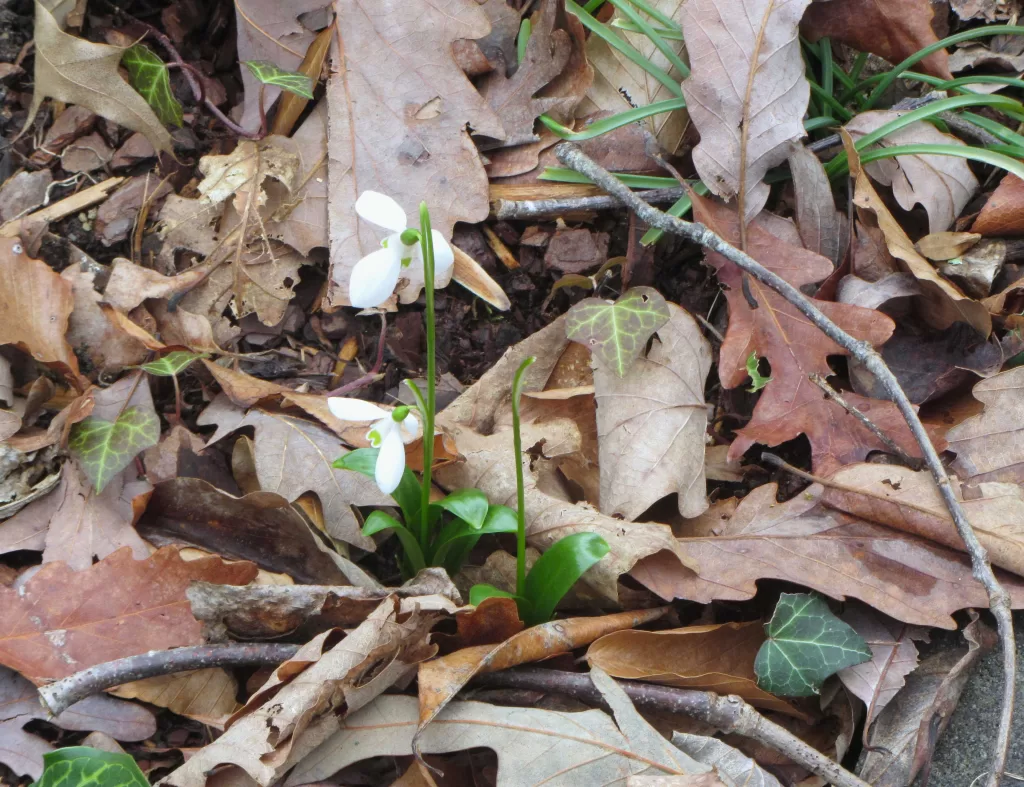
Small bulbs, like Galanthus, grow well under the canopies of large trees. They are planted in the top 2″-3″ of soil and so planting them doesn’t disturb the tree’s roots. These grow under a mature oak, with a variety of other geophytes and ferns that come and go with the seasons.
- One can also grow sun-loving bulbs under deciduous trees. By the time the tree’s leaves reappear, the bulbs will be nearly finished. Bulbs love drier soils during their dormant season, so dry shade under a mature tree suits them perfectly from May through January. It is common to plant bulbs under fruit trees and in meadows in many parts of the world.
- Bulbs planted in a lawn or field will bloom early in the season before the time for the first mowing. Allowing a few extra weeks of growth in the spring for bulbs and wildflowers to bloom and refuel benefits wildlife in numerous ways. Insects, birds, and other small animals will find plenty of food in the unmown grass. And the environment will benefit in general from fewer mowings during the season. By waiting until early May to mow, any clover in the lawn will also fix more free fertilizer, nitrogen, into the soil. Most importantly, a ‘bee meadow’ full of bulbs and wildflowers is a stunningly beautiful sight each spring.
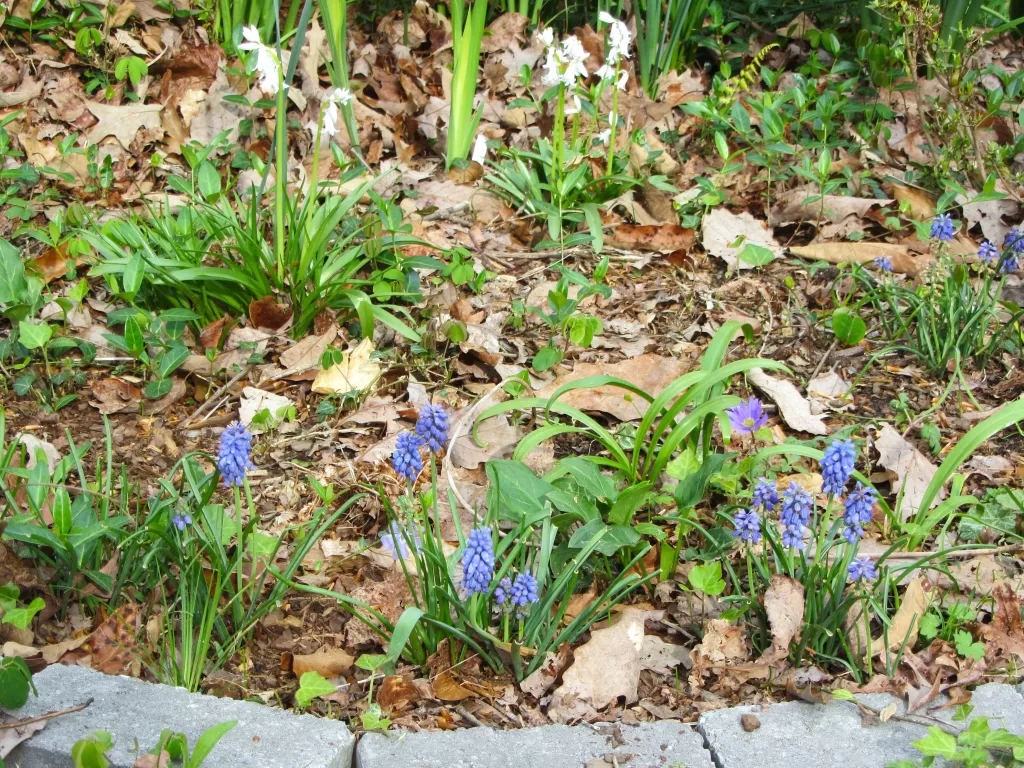
Muscari, Hyacinthoides, and Anemone blanda ‘Blue Shades’ have taken over from the earlier Galanthus, whose leaves continue feeding the bulb in early spring. Iris and ferns have begun their spring growth in the shade of a large oak tree and a shrub border. April 2023.
- Every growing plant, no matter how small or large, ‘breathes’ through tiny holes in its leaves to power its food-making photosynthesis. Just as we breathe in oxygen every moment of our lives, plants breathe in carbon dioxide, nitrogen, and other gasses in the air to use in making the complex sugars and carbohydrates they need for growth. Carbon is an important part of the structure of every plant cell. So every plant, even the pretty ones, filter the air while also returning oxygen and water vapor on their ‘exhale.’ As with every other plant, flowering bulbs also draw water from the soil and release what they don’t use for their own purposes back into the atmosphere. This helps handle soggy soils after spring rains.
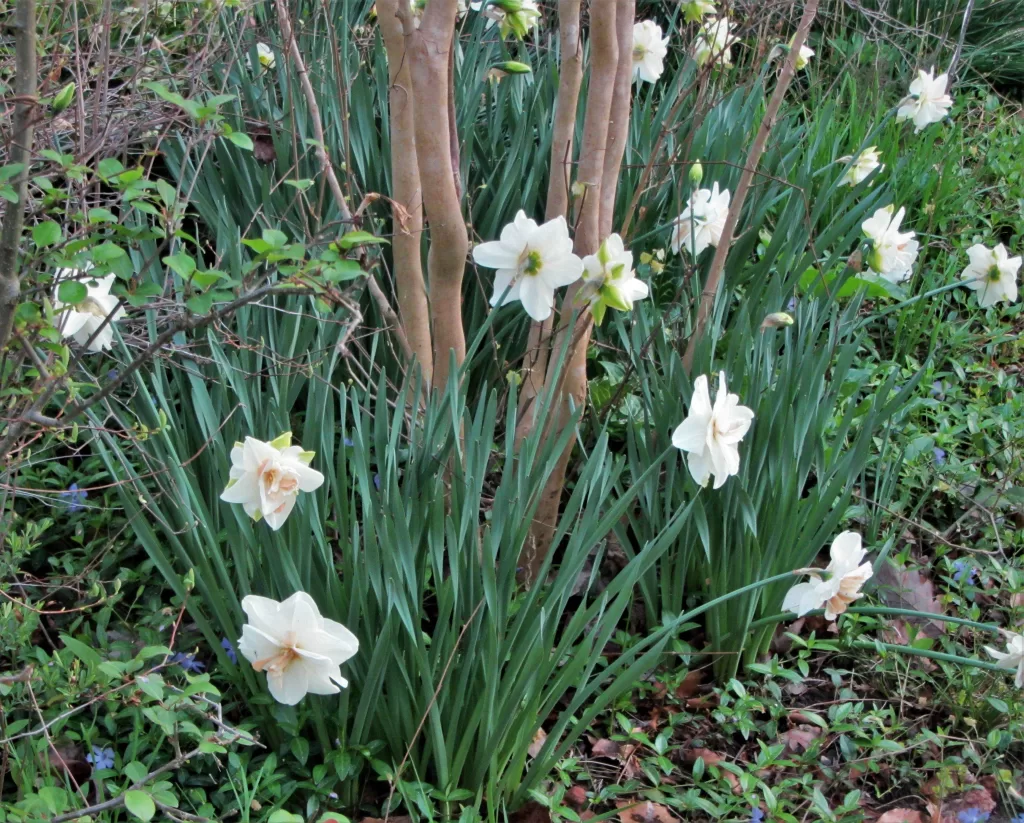
Narcissus leaves filter the air, while their roots and bulbs protect this young crape myrtle tree from burrowing voles. Every part of the Narcissus is poisonous, including its roots, and so deer, rabbits, and voles avoid them and the plants they protect. April 2023.
- Bulbs also grow significant root systems, which help hold soil against erosion during heavy rains. Those long roots seek out minerals deep in the soil and bring them up to shallower layers as they break up compacted soils. As the roots decay in summer, they add organic matter to the soil around where the bulbs lie dormant. So over time, bulbs improve the soil where they grow.
- Bulbs make good companions for annuals, small shrubs, and perennials in four season container gardens. Bulbs may be the first plants to bloom each spring and fade away as other plants take center stage. It is easy to plant layers of bulbs into a container that will provide several months of interest and flowers.
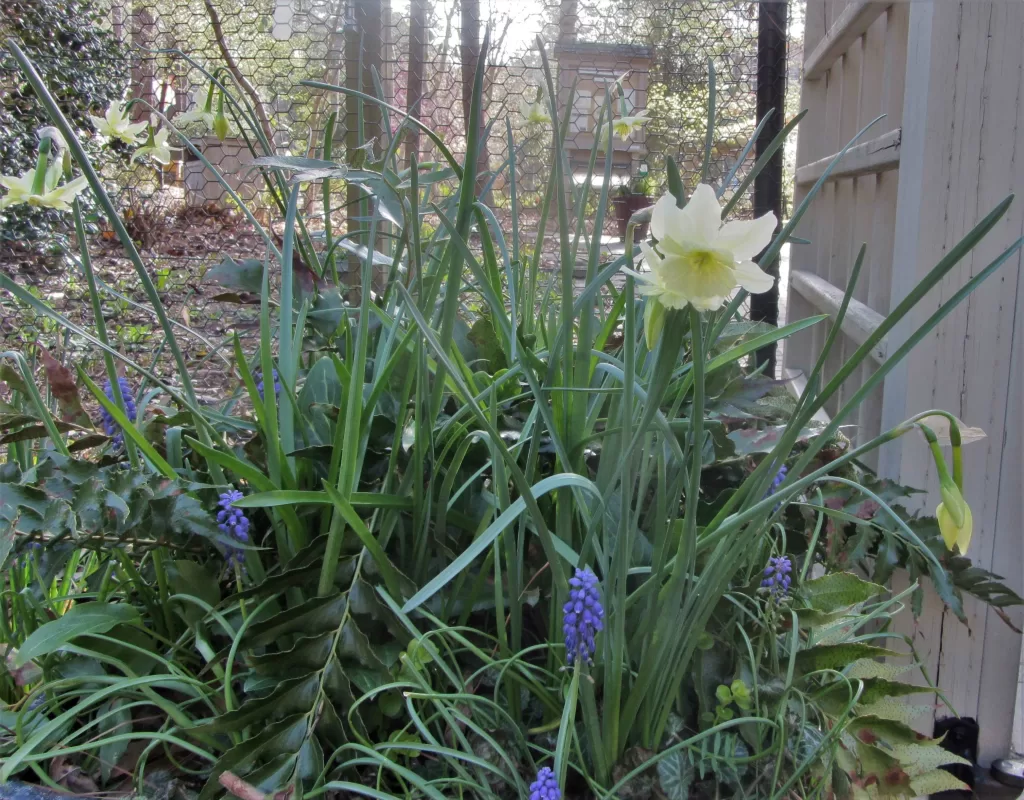
Narcissus ‘Exotic Mystery’ and Muscari bloom alongside an evergreen holly fern, Saxifraga, and other perennials. Other dormant perennials will emerge as the bulbs die back later in the spring. April, 2022 at the main gate of the WBG-FPA.
- Most plants from bulbs are virtually pest-free and easy maintenance. They won’t require spraying, pruning, or other special care. Though pollinators will find them to feed, other insect pests, like aphids, simply aren’t a problem so early in the season. Many people dead head spent flowers for a neater appearance, but this isn’t necessary. Leaving the flowers may result in seeds to help increase the collection in future years.
- Most geophytes are extremely long-lived. Narcissus still grow in ditches, along roadsides, and around old, abandoned homes where no one has cared for them or fussed over them for decades or longer. Many bulbs will perennialize over time by self-seeding. Healthy bulbs increase annually. A single bulb planted this year will multiply into a clump of bulbs after a few seasons. Many gardeners dig up these clumps and divide them every few years to spread favorite flowers to new areas. Bulbs are a very cost-effective investment.
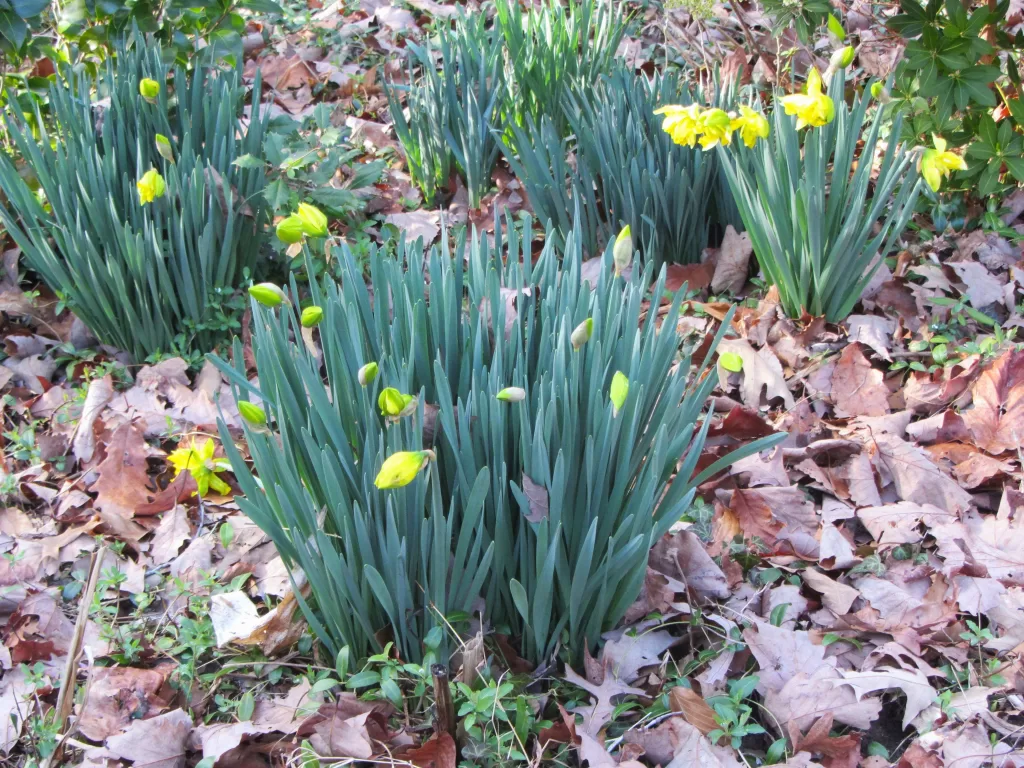
This heirloom variety of daffodil, N. ‘Double Van Scion,’ is one of the older varieties whose history can be traced back to 17th century London. It was first recorded in 1620. These clumps have grown in this garden for more than 20 years. March 2024.
European immigrants making the journey by sea to colonize North America often came with Narcissus bulbs sewn into the hems or linings of their clothing. The flowers from home were so important to them that they found a way to bring bulbs with them to their new homes in America. Flowering bulbs are an important part of our own cultural history. It is easy and affordable to make them a beautiful feature of our late winter and spring time gardens.
Pro Tips: (Thanks to Brent Heath, owner of Brent and Becky’s Bulbs in Gloucester, Virginia)
Before planting bulbs, first spray them with an organic, liquid animal repellent spray to discourage mice, voles, squirrels, and other animals that might smell them and decide to have a nibble. Poisonous bulbs, like Narcissus, don’t need this treatment. But spray all other bulbs, giving them a few minutes to dry before planting them. After planting, water, and spread mulch over the planting area whether you have planted in the ground or in a container. Compost is the best fertilizer for bulbs and can be worked in to the soil while you are planting or used as mulch over the planting area.
All photos by E. L. McCoy
To Learn More:
Kingsbury, Noel and Jo Whitworth. Daffodil: The Remarkable Story of the World’s Most Popular Spring Flower. Timber Press 2013.
McCoy, Elizabeth. “For Love of Narcissus.” James City County Williamsburg Master Gardeners. 2022.

